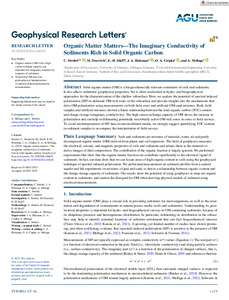| dc.date.accessioned | 2024-03-01T12:06:12Z | |
| dc.date.available | 2024-03-01T12:06:12Z | |
| dc.date.issued | 2023-12-01 | |
| dc.identifier | doi:10.17170/kobra-202403019706 | |
| dc.identifier.uri | http://hdl.handle.net/123456789/15523 | |
| dc.description.sponsorship | Gefördert durch den Publikationsfonds der Universität Kassel | ger |
| dc.language.iso | eng | |
| dc.rights | Namensnennung 4.0 International | * |
| dc.rights.uri | http://creativecommons.org/licenses/by/4.0/ | * |
| dc.subject.ddc | 530 | |
| dc.subject.ddc | 550 | |
| dc.title | Organic Matter Matters—The Imaginary Conductivity of Sediments Rich in Solid Organic Carbon | eng |
| dc.type | Aufsatz | |
| dcterms.abstract | Solid organic matter (OM) is a biogeochemically relevant constituent of soils and sediments. It also affects sediments' geophysical properties, but is often overlooked in hydro- and biogeophysical approaches for the characterization of the shallow subsurface. Here, we explore the potential of spectral induced polarization (SIP) to delineate OM-rich zones in the subsurface and provide insights into the mechanisms that drive OM-polarization using measurements on both field cores and artificial OM-sand mixtures. Both, field samples and artificial mixtures showed a linear relationship between the total organic carbon (TOC) content and charge storage (imaginary conductivity). The high cation exchange capacity of OM drives the increase in polarization and can help in delineating potentially microbially active OM-rich zones in cores or field surveys. To avoid misinterpretation of SIP data in unconsolidated media, we strongly suggest quantifying TOC content in sediment samples to accompany the interpretation of field surveys. | eng |
| dcterms.accessRights | open access | |
| dcterms.creator | Strobel, Cora | |
| dcterms.creator | Dörrich, Manuel | |
| dcterms.creator | Stieff, Emma-Helen | |
| dcterms.creator | Huisman, Johann Alexander | |
| dcterms.creator | Cirpka, Olaf A. | |
| dcterms.creator | Mellage, Adrian | |
| dcterms.description | Plain Language Summary:
Soils and sediments are mixtures of minerals, water, air and partly decomposed organic matter (OM) derived from plants and soil organisms. The field of geophysics measures the electrical, seismic, and magnetic properties of soils and sediments and relates them to the minerals to derive images of their composition. The contribution of the organic fraction is largely ignored. We performed experiments that show that the organic-matter fraction can contribute significantly to the electrical signal of sediments. In fact, our data show that we can locate areas of high organic content in soils using the geophysical technique of spectral induced polarization. We performed measurement on sediment profiles from a natural aquifer and lab experiments on mixtures of peat and sand, to derive a relationship between organic content and the charge storage capacity of sediments. Our results show the potential of using geophysics to map out organic content in sediments, and caution the disregard for OM when deriving physical models of sediment using electrical measurements. | |
| dcterms.description | Key Notes:
• Organic matter (OM) with a high
cation exchange capacity can
dominate the imaginary conductivity
response of sediments
• Neglecting OM may bias
petro-physical interpretations
of spectral induced polarization
measurements | |
| dc.relation.doi | doi:10.1029/2023GL104630 | |
| dc.subject.swd | Natürliches organisches Material | ger |
| dc.subject.swd | Kohlenstoff | ger |
| dc.subject.swd | Boden | ger |
| dc.subject.swd | Sediment | ger |
| dc.subject.swd | Leitfähigkeit | ger |
| dc.type.version | publishedVersion | |
| dcterms.source.identifier | eissn:1944-8007 | |
| dcterms.source.issue | Issue 23 | |
| dcterms.source.journal | Geophysical Research Letters | eng |
| dcterms.source.volume | Volume 50 | |
| kup.iskup | false | |
| dcterms.source.articlenumber | e2023GL104630 | |


